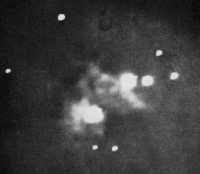Orion Nebula through the ages: iPhone vs observatory
posted Wednesday, March 5, 2014 at 4:47 PM EST

What do Henry Draper, born 1837, physician and professor of medicine, and Andrew Symes of Ottawa, Canada, have in common? Probably not much, one might think, apart from being residents of countries located on the North American continent. But there are two small details creating a link between the two: an interest in amateur astrophotography and a fascination with the Orion nebula.
Back in the year of 1880, Henry Draper was the first to successfully take a photograph of the Orion nebula. Unlike Andrew Symes, Draper had an actual observatory at his disposal, but even the most high-tech devices of the late 19th century are easily outperformed by today's consumer equipment. So it comes as no surprise that Symes' pictures of the Orion Nebula show much more definition than Draper's, and have been much easier to create.
For his photograph of the nebula, Draper used an 11-inch Clark Brothers photographic refractor according to Wikipedia, and the exposure took 51 minutes. The result was a grainy black-and-white picture in which most of the observable stars are overexposed and reproduced as patches of white. But nontheless it was quite an achievement in its day, and secured Draper a safe spot in the history books.
Fast forward to the year 2013, and Andrew Symes demonstrates that an iPhone paired to an amateur telescope does a much better job at capturing celestial objects than the equipment that Draper used back in his day. Admittedly, the whole process involves more than just pointing the telescope at the Orion Nebula and taking an exposure, but it is much less of a hassle than working with an observatory-size telescope and photographic film.
All the more striking is the fact that Symes' iPhone image from 2013 looks so similar to Draper's black-and-white film photo from 1880, despite all the difference in technology and the additional color information in the iPhone photograph. This is mostly due to the slight overexposure of the stars that is present in Symes' photograph, and the similar amount of detail in both pictures. Overall though, Symes' photo taken with 21st century equipment has much more clarity and definition to it.
If Draper could see Symes' work, he would surely be thrilled with it. We can, and we are, and there is more of it available in his Flickr stream.
(via io9)